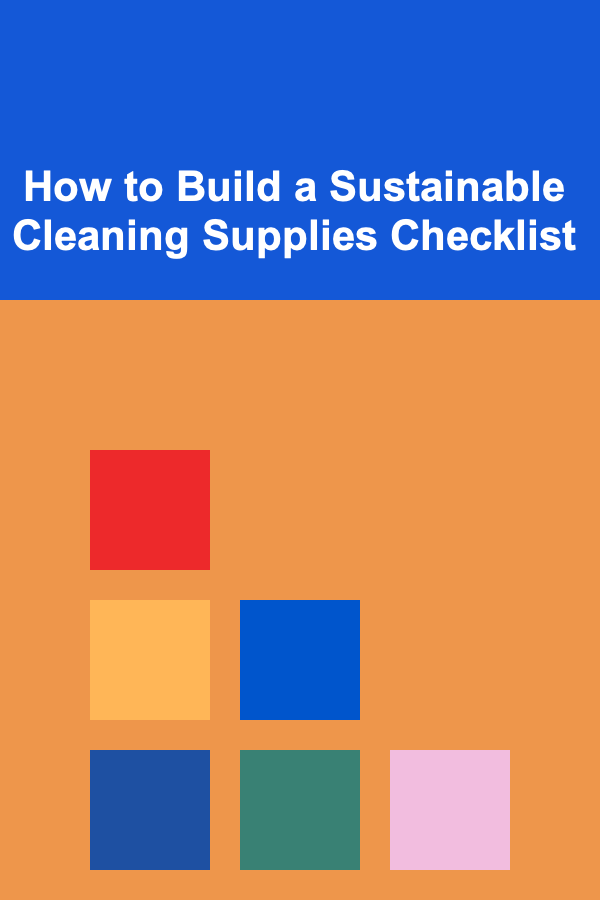
How to Build a Sustainable Cleaning Supplies Checklist
ebook include PDF & Audio bundle (Micro Guide)
$12.99$6.99
Limited Time Offer! Order within the next:

As the world becomes increasingly aware of the environmental challenges we face, there is a growing demand for sustainable practices in every area of life. One essential area that often gets overlooked is cleaning supplies. Traditional cleaning products, although effective, can be harmful to both the environment and your health. With harmful chemicals, excessive packaging, and unsustainable sourcing practices, they contribute to pollution, toxic exposure, and waste. In this article, we'll explore how to build a sustainable cleaning supplies checklist that can help you create a cleaner, safer, and more eco-friendly home.
Why Choose Sustainable Cleaning Supplies?
Before diving into the specifics of creating a sustainable cleaning supplies checklist, it's important to understand the environmental and health-related reasons for switching to sustainable products.
-
Health Benefits
Many conventional cleaning products contain toxic chemicals, which can be harmful when inhaled or absorbed through the skin. These chemicals may cause skin irritation, respiratory problems, and other long-term health issues. Sustainable cleaning products, on the other hand, use natural ingredients that are much gentler on the body, making them safer for your family, including children and pets.
-
Reduced Chemical Pollution
Cleaning products often end up in our wastewater systems, contributing to chemical pollution in the environment. Many of these chemicals are not easily filtered out by water treatment plants, eventually finding their way into rivers, lakes, and oceans. Sustainable cleaning products are biodegradable, meaning they break down more easily and have a much smaller environmental impact.
-
Minimized Plastic Waste
Traditional cleaning products are usually sold in plastic bottles, which contribute to the growing issue of plastic waste. By choosing eco-friendly cleaning supplies, especially those with reusable or recyclable packaging, you can significantly reduce your plastic footprint.
-
Better for Wildlife
Many conventional cleaning products contain ingredients that can harm wildlife if they enter ecosystems. By opting for sustainable alternatives, you can help prevent the contamination of natural habitats and protect local wildlife.
Step 1: Assess Your Current Cleaning Supplies
The first step in creating a sustainable cleaning supplies checklist is to assess your current cleaning routine. Take inventory of the cleaning products you already have in your home. Consider their ingredients, packaging, and effectiveness. Ask yourself the following questions:
- Are the cleaning products I use made with natural, non-toxic ingredients?
- Do they come in plastic packaging that can't be recycled?
- Are they effective in achieving the results I want?
- Are there any unnecessary chemicals that could be replaced with safer alternatives?
Once you've assessed your cleaning supplies, it will be easier to identify areas where you can make changes and switch to more sustainable options.
Step 2: Choose Eco-Friendly Ingredients
When choosing cleaning products, it's crucial to prioritize ingredients that are safe for both people and the planet. Look for products that are free of harsh chemicals like ammonia, bleach, and phthalates. Opt for natural ingredients like vinegar, baking soda, lemon, and essential oils. These ingredients are effective at cleaning and disinfecting, but they're also safe, non-toxic, and biodegradable.
Key Ingredients for Sustainable Cleaning:
- Vinegar: A powerful cleaner that can remove dirt, stains, and odors. It also works as a natural disinfectant.
- Baking Soda: A versatile cleaner that can scrub surfaces, neutralize odors, and clean drains.
- Lemon: Its acidic properties help remove grease and stains. It also acts as a natural deodorizer.
- Castile Soap: A gentle, plant-based soap that can be used for a variety of cleaning tasks.
- Essential Oils: These oils not only add fragrance but also have natural antimicrobial properties, making them perfect for cleaning.
DIY Cleaning Solutions
If you want to take sustainability a step further, you can create your own cleaning products at home. By using simple ingredients like vinegar, water, baking soda, and essential oils, you can create effective and affordable cleaning solutions that are free of harmful chemicals and plastic packaging.
Step 3: Choose Reusable and Eco-Friendly Tools
Another important aspect of building a sustainable cleaning supplies checklist is selecting reusable and eco-friendly cleaning tools. Disposable cleaning items like paper towels, disposable wipes, and plastic sponges contribute to excessive waste. By switching to reusable options, you can reduce your environmental impact and save money in the long run.
Recommended Reusable Cleaning Tools:
- Microfiber Cloths: These cloths are highly effective at picking up dust, dirt, and grime without the need for chemical cleaners. They can be washed and reused, reducing waste.
- Reusable Mop Pads: Instead of using disposable mop pads, opt for washable mop pads that can be reused many times.
- Bamboo Brushes: Bamboo is a sustainable material that can be used for scrubbing. Choose bamboo brushes over plastic alternatives to reduce waste.
- Glass or Stainless Steel Spray Bottles: Invest in a good-quality glass or stainless steel spray bottle. These can be refilled with your homemade or eco-friendly cleaning solutions, reducing the need for single-use plastic bottles.
- Cloth Rags: Rather than using paper towels for cleaning, consider switching to old rags or cloth towels that can be washed and reused.
Step 4: Choose Products with Minimal or Recyclable Packaging
Packaging is one of the most significant contributors to waste in the cleaning supply industry. Many conventional cleaning products come in plastic bottles or containers that are difficult to recycle. To reduce your environmental impact, look for products with minimal packaging or packaging made from recycled materials.
Packaging Tips:
- Refill Stations: Some stores offer refill stations where you can refill your own containers with cleaning products. This is a great option if you want to avoid purchasing new plastic bottles.
- Concentrates: Concentrated cleaning products require less packaging and shipping materials. By purchasing concentrates, you can mix your own cleaning solutions at home, saving both plastic and money.
- Recycled Packaging: Look for products that come in containers made from recycled or recyclable materials. Many brands now offer cleaning supplies in cardboard, aluminum, or glass containers.
Step 5: Research Sustainable Brands
When it comes to choosing sustainable cleaning supplies, it's essential to support brands that are committed to eco-friendly practices. Many brands are now offering sustainable, non-toxic cleaning products, but not all are equally transparent about their environmental impact. Look for brands that are certified by trusted organizations, such as:
- EPA Safer Choice: This certification ensures that a product is safer for human health and the environment.
- Cradle to Cradle: This certification indicates that the product is designed with sustainability in mind, from raw materials to end-of-life disposal.
- Leaping Bunny: This certification ensures that a brand does not test its products on animals.
Some popular sustainable cleaning brands include:
- Method
- Seventh Generation
- Dr. Bronner's
- Ecos
- Blueland
Step 6: Build Your Sustainable Cleaning Supplies Checklist
With all this information, you can now build your sustainable cleaning supplies checklist. Here's a sample checklist to guide you:
Sustainable Cleaning Supplies Checklist:
1. All-Purpose Cleaner
- Ingredients: Vinegar, water, essential oils
- Packaging: Glass or stainless steel spray bottle
- Brand: Blueland, Method
2. Bathroom Cleaner
- Ingredients: Baking soda, vinegar, essential oils
- Packaging: Recyclable packaging or refillable container
- Brand: Seventh Generation, Method
3. Floor Cleaner
- Ingredients: Castile soap, water, essential oils
- Packaging: Reusable mop pads
- Brand: Ecover, Dr. Bronner's
4. Window and Glass Cleaner
- Ingredients: Vinegar, water, essential oils
- Packaging: Glass spray bottle
- Brand: Method, Blueland
5. Dish Soap
- Ingredients: Plant-based ingredients, essential oils
- Packaging: Recyclable packaging or bulk refill
- Brand: Dr. Bronner's, Ecos
6. Laundry Detergent
- Ingredients: Plant-based, biodegradable ingredients
- Packaging: Recycled packaging or refillable container
- Brand: Molly's Suds, Seventh Generation
7. Scrub Brushes and Sponges
- Material: Bamboo, natural fibers
- Packaging: Minimal or recyclable
- Brand: Scrub Daddy, Redecker
8. Cleaning Cloths
- Material: Microfiber, organic cotton
- Packaging: Minimal or eco-friendly packaging
- Brand: Grove Collaborative, Etsy (handmade)
Step 7: Maintain Your Sustainable Routine
Once you've created your sustainable cleaning supplies checklist, it's important to maintain the routine by continuously evaluating your products, staying informed about eco-friendly alternatives, and making gradual improvements as new products emerge. Always prioritize products that align with your values and environmental goals.
Conclusion
Building a sustainable cleaning supplies checklist is a meaningful way to reduce your environmental footprint while maintaining a clean and healthy home. By choosing natural ingredients, reusable tools, and eco-friendly packaging, you can make a positive impact on both your health and the planet. Start small, make incremental changes, and over time, you'll find that creating a sustainable cleaning routine is not only effective but rewarding. Together, we can contribute to a cleaner, greener world, one cleaning supply at a time.
Reading More From Our Other Websites
- [Personal Care Tips 101] How to Choose Antiperspirant for Hot Weather or Tropical Climates
- [Personal Care Tips 101] How to Lose Weight Without Feeling Deprived
- [Home Storage Solution 101] How to Declutter and Organize Your Medicine Cabinet for a Stress-Free Morning Routine
- [Home Security 101] How to Secure Your Home's Doors and Windows Effectively
- [Personal Care Tips 101] How to Find the Best Lipstick for a Professional Look
- [Weaving Tip 101] Mastering Advanced Weaving Techniques: A Guide for the Modern Adult Hobbyist
- [Home Space Saving 101] How to Optimize Storage with a Bookcase with Storage
- [Organization Tip 101] How to Measure and Cut Stair Treads for a Perfect Fit
- [Home Security 101] How to Use Frontpoint Security to Enhance Your Home Protection
- [Home Lighting 101] How to Light Your Entryway for Maximum Impact and Functionality

How to Create a Signature Cocktail for Your Home Party
Read More
How to Organize a Potluck Party with Ease
Read More
How to Save on Monthly Subscription Services for Your Home
Read More
How to Navigate Blockchain Regulations Globally
Read More
How To Draw Fabric and Drapery
Read MoreProperty Tax Tracker: A Comparison of Top Apps & Software
Read MoreOther Products

How to Create a Signature Cocktail for Your Home Party
Read More
How to Organize a Potluck Party with Ease
Read More
How to Save on Monthly Subscription Services for Your Home
Read More
How to Navigate Blockchain Regulations Globally
Read More